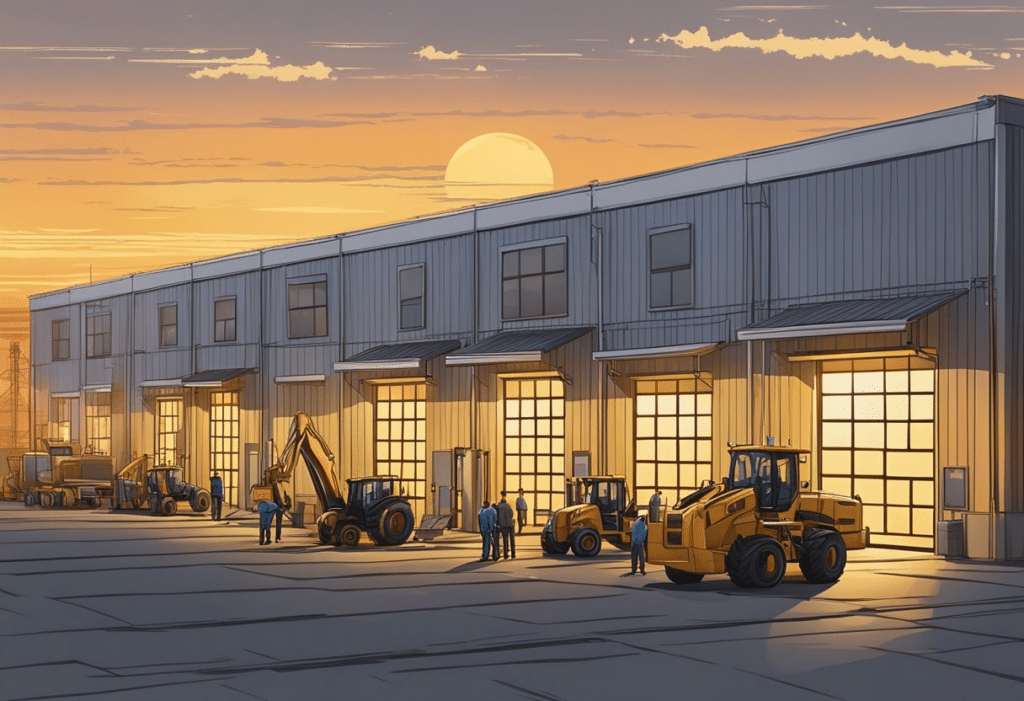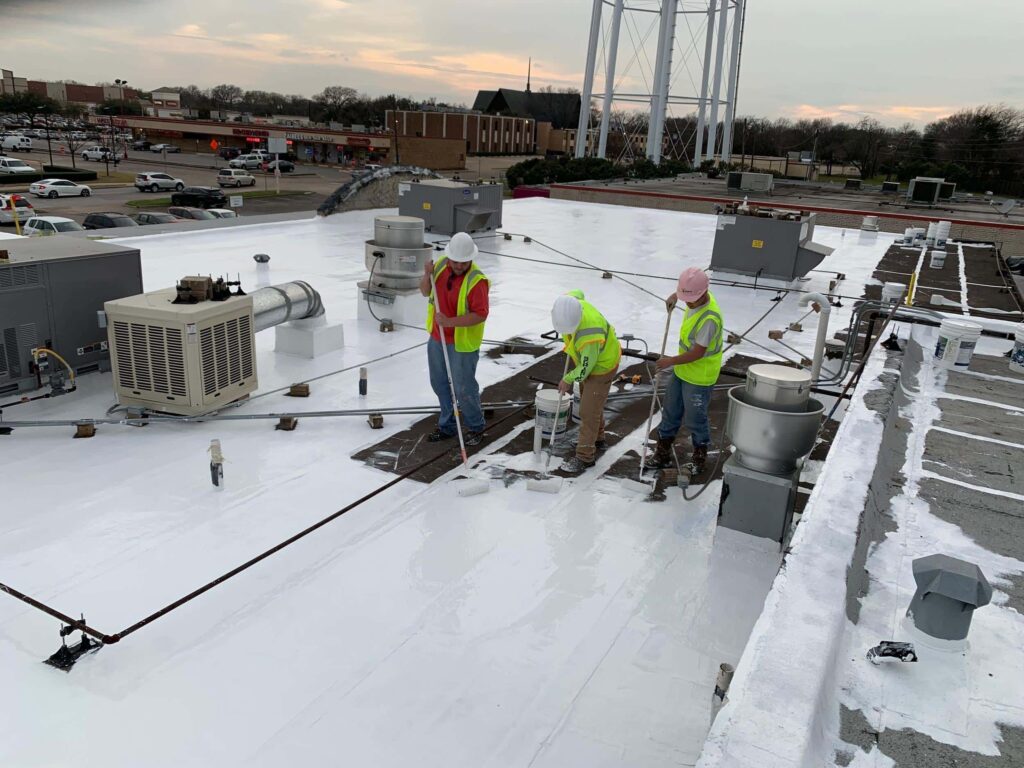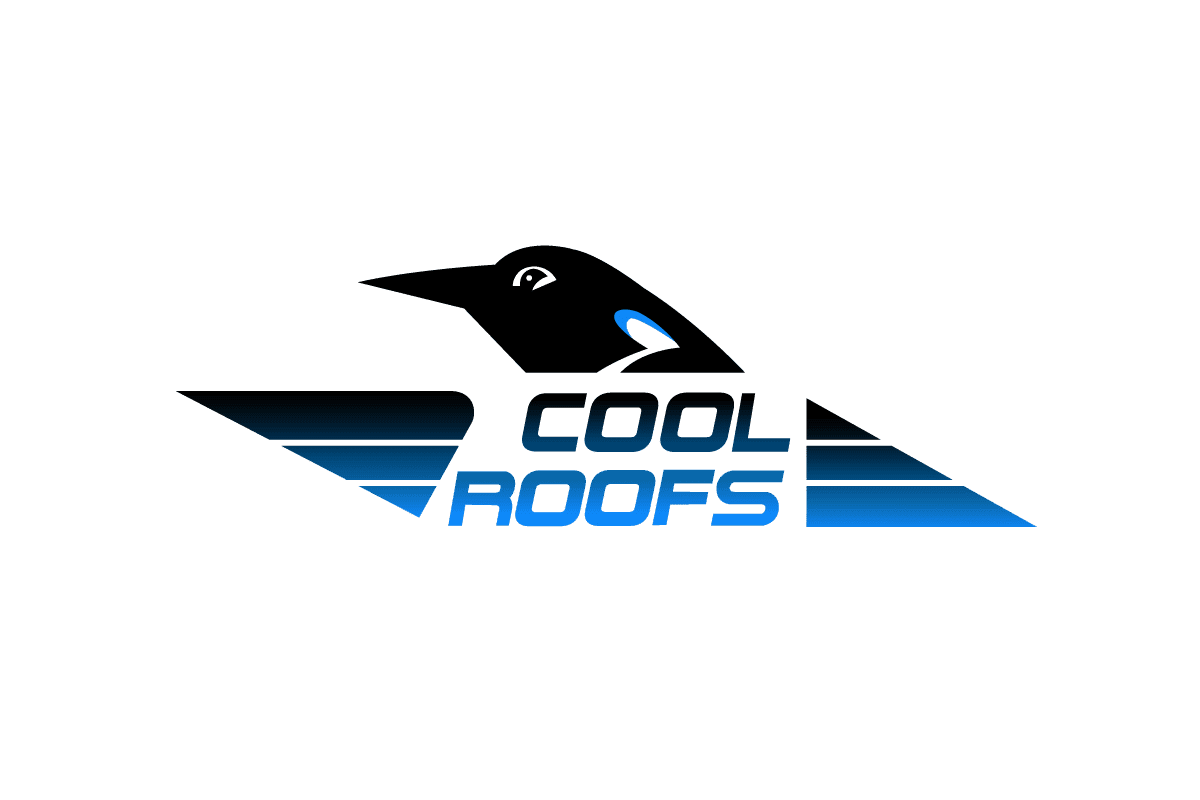In the vibrant city of Austin, Texas, known for its dynamic culture and booming construction, commercial roofing stands as a critical component of building maintenance and infrastructure. As experts in the field, we understand that a robust and reliable roof is a paramount investment for any commercial establishment. The severe weather conditions common to the region, including intense heat, storms, and heavy rain, place significant demands on roofing systems. Acknowledging this, we emphasize the importance of choosing the right materials and services to ensure longevity and durability in Austin’s unique climate.

Commercial roofing in Austin encompasses a diverse range of services, from initial installation to ongoing maintenance and repair. Business owners must take into account the various roofing materials available to them, each with its own advantages and suitability for different building types. Metal roofing, for example, is praised for its resilience and energy efficiency, while flat roofing systems are often selected for their cost-effectiveness and ease of maintenance. Equally critical is the selection of a qualified roofing contractor—expertise and experience in the local market are invaluable for delivering tailored solutions that address the unique challenges Austin’s commercial properties face.
Key Takeaways
- A durable roof is essential for commercial buildings, especially in Austin’s climate.
- Choice of material and skilled installation are key to roofing success.
- Selecting an experienced contractor ensures customized, effective roofing solutions.
Understanding Commercial Roofing in Austin
When considering Austin commercial roofing services, Texas, we prioritize durability and cost-effectiveness. Austin’s climate demands roofing systems that can withstand diverse weather conditions, from scorching heat to torrential rains.
Materials: The choice of materials is crucial. Commercial roofing often involves materials like modified bitumen, EPDM (rubber roofing), and TPO (thermoplastic polyolefin), chosen for their longevity and energy efficiency.
Installation: Proper installation is critical to the lifespan of a roof. We trust professional roofers in Austin who understand the specific needs of commercial properties. They’ll ensure that installation meets city regulations and building codes.
Maintenance: Regular maintenance is a non-negotiable aspect of preserving the integrity of a commercial roof. We recommend semi-annual inspections to identify and rectify potential issues early.
Types of Commercial Roofs:
- Single-Ply Membrane
- Metal Roofing
- Built-Up Roofing (BUR)
- Green Roofing Systems
Advantages of Professional Roofing Services:
- Expertise: Skilled professionals can navigate the complexities of commercial roofing projects.
- Time-Efficiency: Experts in roofing manage projects efficiently, minimizing disruptions to business operations.
- Safety: Compliance with safety standards is paramount, and experienced roofers in Austin upholds these standards during installation and maintenance.
By understanding the dynamics of commercial roofing, we help businesses in Austin protect their investments. Whether it’s selecting the right material, hiring skilled professionals, or scheduling regular maintenance, we ensure a well-informed approach toward commercial roofing needs.
Types of Commercial Roofing Materials

When it comes to commercial roofing in Austin, the materials used are critical for the long-term durability and efficiency of the roof. We will explore the most prevalent types employed in the area.
Metal Roofing Options
Metal roofing is a durable and long-lasting option for commercial buildings. Amongst metal options, copper stands out for its longevity and the elegant patina it develops over time. It’s a premium choice well-suited for businesses looking for a combination of style and durability. Other commonly used metals include aluminum and steel, which can be treated with various coatings to improve their resistance to rust and increase reflectivity, reducing energy costs.
Single-Ply Membranes
Single-ply membranes are a class of materials that are installed in one layer. Two popular materials in this category are TPO (Thermoplastic Olefin) and EPDM (Ethylene Propylene Diene Monomer). TPO is notable for its heat-reflective properties and strength, making it a cost-effective and energy-efficient roofing option for commercial buildings. EPDM, on the other hand, is valued for its durability and flexibility, which is crucial in areas with a wide temperature range.
Built-Up Roofing (BUR) Systems
Built-Up Roofing (BUR) Systems, also known as tar and gravel roofs, have been a reliable mainstay in commercial roofing for over a century. BUR consists of multiple layers of bitumen and reinforcing fabrics that create a finished membrane. This type of roofing material is appreciated for its ability to provide a continuous sealed surface, which offers robust protection against water penetration and the elements. BUR is one of the toughest materials available, often chosen for its resilience and longevity.
Commercial Roofing Services
In the bustling city of Austin, we cater to a diverse array of commercial roofing needs, from initial installation to regular maintenance and complete replacements, ensuring business continuity with robust roofing solutions.
Installation Services
We pride ourselves on the installation of commercial roofs tailored specifically for durability and energy efficiency. Whether it’s a new construction or retrofitting an existing building, our team ensures that your commercial properties are equipped with the best materials, like metal roofing, to suit the local Austin climate.
Repair and Maintenance
Regular commercial roof maintenance is crucial in preventing leaks and other costly damages. We conduct thorough inspections and timely repairs, addressing potential issues before they escalate. By prioritizing roof repair, businesses can avert unexpected disruptions and extend the lifespan of their roofs.
Roof Replacement Services
When repairs are no longer a viable option, we provide roof replacement services. Our approach includes removing the old roofing system, assessing the structural integrity, and installing a new roof that meets all safety standards and performance expectations, ensuring a comprehensive solution to your roofing needs.
Selecting a Commercial Roofing Contractor
When we’re in the market for commercial roofing services, choosing the right contractor is crucial to ensure the longevity and effectiveness of our investment. To begin, we focus on finding knowledgeable roofing contractors with a solid reputation in the industry. Each contractor’s experience reflects their ability to handle diverse roofing challenges, which is essential to us.
We then consider the contractor’s standing with the Better Business Bureau (BBB). A high rating from BBB is indicative of a trustworthy business, exemplified by Cool Roofs, which holds an A+ rating for its services in Austin, TX.
Getting a free quote is an excellent step to understanding the financial aspect of the roofing project while also getting a feel for the contractor’s responsiveness and willingness to provide detailed, upfront information. We prefer contractors who offer transparent pricing without hidden charges.
Here’s a quick checklist to help us decide:
- Experience: Confirm past project similarities.
- Reputation: Check their BBB rating and reviews.
- Estimate: Obtain a detailed and free quote.
- Warranties: Ensure clear material and labor guarantees.
- Communication: Gauge responsiveness and clarity.
By following these criteria, we ensure our selection process remains rigorous and provides us with peace of mind that we’re entrusting our business’s roofing needs to the best commercial roofing contractors available.
Commercial Roofing Challenges and Solutions
When addressing Austin commercial roof replacements and repairs, it is crucial to consider the unique weather conditions and their impact on materials. Our expertise in this domain allows us to pinpoint specific challenges and implement effective solutions to maintain structural integrity and energy efficiency.
Weather-Related Damage
Austin’s climate can be harsh on commercial roofs, with hail and wind posing significant threats. To combat these issues, we recommend robust materials and proper installation techniques. For hail, impact-resistant materials lessen the likelihood of dents and punctures. In the case of wind, we ensure that roofing components are securely fastened to withstand high wind events, reducing the risk of blow-offs or uplift.
- Challenge: Hail impact on roofing surfaces.
- Solution: Use impact-resistant materials.
- Challenge: Wind causing uplift and damage.
- Solution: Properly secured roofing components.
Material-Specific Issues
Flat roofing offers numerous benefits for commercial properties but also demands careful consideration when it comes to leaks and commercial roof repair. Regular maintenance is vital to address small issues before they escalate. In Austin, where the sun is intense, reflective coatings can prevent premature ageing of the roofing material.
- Material Issue: Susceptibility to leaks.
- Key Measure: Regular inspections and maintenance.
- Material Issue: Deterioration under UV exposure.
- Key Measure: Application of reflective coatings.
Energy Efficiency Concerns
Commercial buildings often strain under high energy costs. A focus on energy efficiency not only saves money but also contributes to a more sustainable operation. By incorporating insulative materials and cool roofing options, we can significantly reduce a building’s cooling requirements.
- Concern: High energy consumption for cooling.
- Solution: Install insulative roofing materials.
- Concern: Heat retention in roofing materials.
- Solution: Implement cool roofing technology.
By taking a proactive approach to these challenges and implementing tailored solutions, we can enhance the longevity and performance of a commercial roof in Austin’s unique environment.
Regional Considerations for Austin and Surrounding Areas
In Austin and its neighboring communities, including Cedar Park, Georgetown, Round Rock, and Lakeway, we experience a climate that poses unique challenges for commercial roofing. The area is known for its hot summers and variable weather, which means roofing materials need to be highly durable and reflective to combat UV radiation and heat.
- Storms and Wind Damage: Areas like Killeen, Taylor, and San Marcos often face severe storms and high winds, making resistance to wind uplift a top priority for roofing systems.
- Humidity and Mildew: Pflugerville and Hutto, with their high humidity, require roofing materials that prevent mildew growth.
- Heat Resistance: Bastrop and Buda benefit from roofs with excellent heat resistance to reduce cooling costs.
Here’s a brief look at the specific considerations across the region:
| City | Consideration |
|---|---|
| Leander | Periodic hail requires impact-resistant roofs |
| Kyle | Heat mitigation is crucial for energy efficiency |
| Elgin | Durable materials to endure fluctuating weather patterns |
| Lago Vista | Roofs must be capable of handling the occasional snow |
We also recognize regional architectural styles and local ordinances that may dictate specific materials or designs in places like Waco and Round Rock. It’s essential to ensure that roofs not only serve a protective purpose but also adhere to the aesthetic standards of the community.
Choosing the right commercial roofing contractor is vital, as they will be familiar with the regional challenges and the best materials and practices. If you’re looking to repair, replace, or install a new roof, it’s important to trust a team that understands these unique requirements.
Commercial Roofing Case Studies
In our examination of commercial roofing projects, we have observed a variety of cases that highlight the different challenges and solutions within the industry, particularly focusing on Austin commercial roofing.
Case Study Highlights:
- Project Overview: We have completed full-range commercial services from fabrication to installation and beyond. Our work includes regular roof repair and maintenance, ensuring longevity and performance.
- Innovative Solutions: On complex sites with multiple penetrations, such as educational institutions, we’ve recommended advanced systems like the HydroStop® PremiumCoat® System to enhance durability.
Our Approach:
- Inspection: Detailed initial assessments lay the groundwork for precise services tailored to each commercial building’s unique needs.
- Maintenance: We’ve devised ongoing maintenance programs that address the commercial roofing needs of Austin businesses, promoting sustainability and cost-effectiveness.
- Repairs and Replacement: Whether dealing with weather damage or aging structures, our team is adept at both roof repair and roof replacement, assuring a reliable roofing system.
Key Outcomes:
- Durability: Through our dedicated services, roofs have withstood the test of time and Austin’s varied climate, demonstrating our commitment to quality.
- Insurance Considerations: Our roofing solutions have been conscientious about clients’ insurance, avoiding unnecessary raises in premiums.
Examining these case studies gives us clear evidence of our adaptive strategies and result-oriented practices in meeting the diverse commercial roofing requirements in Austin.
FAQ to Ask Your Austin Commercial Roofing Company
When considering commercial roofing in Austin, risks like extreme weather and how it impacts longevity and maintenance are typical concerns for business owners.
What materials are commonly used for commercial roof systems in Austin?
- Thermoplastic polyolefin (TPO) is prevalent in Austin due to its heat-reflective properties.
- Metal roofs are valued for their durability and energy efficiency.
- Modified bitumen is chosen for its versatility and ease of repair.
How long does a commercial roof last in Austin?
TPO roofs, with proper maintenance, can last for over 30 years. However, the lifespan of a roof also depends on the type of material used and the quality of installation.
What should you consider when choosing a commercial roofer in Austin?
- Verify their experience and local customer satisfaction.
- Investigate the range and quality of services they offer.
- Check for warranties, underscoring the roofer’s confidence in their work and its potential impact on return on investment.
What maintenance is required for a commercial roof in Texas?
- Regular inspections to address wear and prevent leaks.
- Prompt repairs, given Texas’ harsh weather conditions.
- Cleaning to prevent debris buildup and water damage.
We take commercial roofing seriously in Austin, Texas, and as professionals, we strive to provide transparent advice to support your business’s needs. Choose a roofer who values timeliness and respects your budget, like Cool Roofs, to ensure your investment is sound and long-lasting.
Choose Cool Roofs for Your Commercial Roofing Austin Needs!

